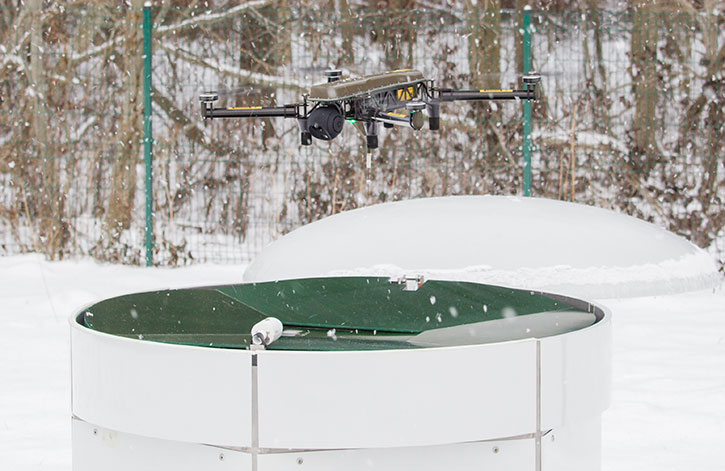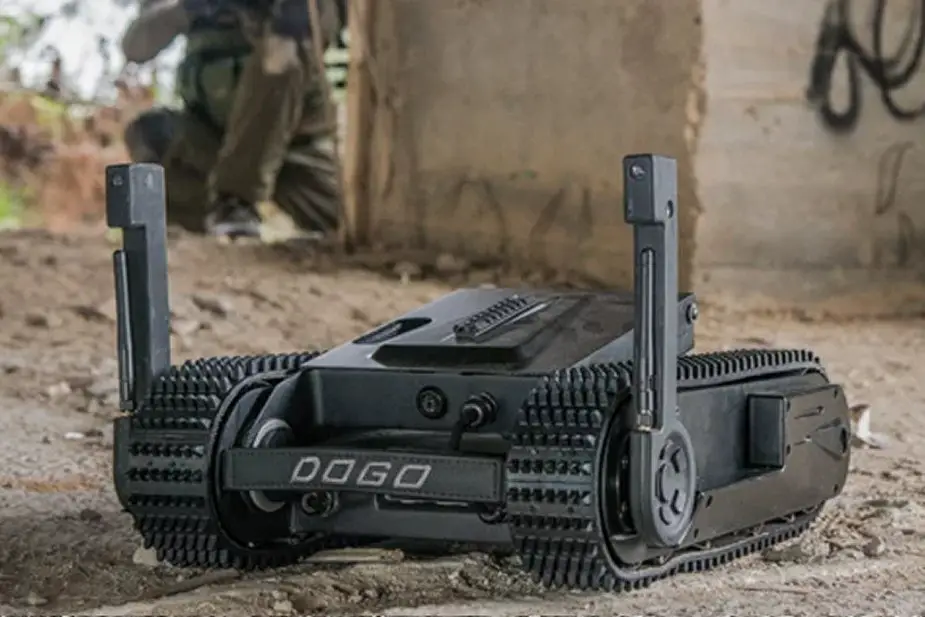https://hackaday.com/2017/10/26/skynet-will-have-bobcats/There are so many autonomous devices nowadays that can run Skynet Inside(TM) that it’s hard to keep track. But one was still missing: the versatile Bobcat. When we say “Bobcat”, we mean track loader — it’s just one of those things that the name and the brand stoke together so strongly that it’s hard to actually recall the technical name. A company by the name of Built Robotics is betting on autonomous track loaders as being a big part of the future of construction.
The tractor can navigate, excavate, and carry a 1,000 pound load with 1 cm precision using its LIDAR, specially designed to work with high-vibration, high-impact environment of construction excavation. Additionally, the lasers also allow the robot to measure the amount of material it has scooped up. But the precision does not come from the LIDAR alone. To position the robot, Built Robotics uses augmented GPS, which combines an on-site base station and GPS satellites to produce accurate location data.
Install the app
How to install the app on iOS
Follow along with the video below to see how to install our site as a web app on your home screen.
Note: This feature may not be available in some browsers.
You are using an out of date browser. It may not display this or other websites correctly.
You should upgrade or use an alternative browser.
You should upgrade or use an alternative browser.
UAV / UCAV / LAR (robotit) Uutiset ja jutut
- Viestiketjun aloittaja Raveni
- Aloitus PVM
http://www.wibotic.com/news-release...irst-autonomous-wireless-charging-pad-drones/Introducing WiBotic PowerPad, a completely integrated wireless charging pad for drones. Designed for the many drone operators who don’t want to develop their own wireless charging pad, WiBotic PowerPad contains the WiBotic transmitter circuit, transmitter antenna and power supply in one ready-to-go unit.
https://spectrum.ieee.org/automaton...the-origin-story-of-ros-the-linux-of-roboticsTen years ago, while struggling to bring the vision of the “Linux of Robotics” to reality, I was inspired by the origin stories of other transformative endeavors. In this post I want to share some untold parts of the early story of the Robot Operating System, or ROS, to hopefully inspire those of you currently pursuing your “crazy” ideas.

https://www.armyrecognition.com/wea...mous_loading_unloading_from_mv-22_osprey.htmlStratom has been working on the XR-P for about three years, in response to a Small Business Innovation Research proposal for resupply systems to work with the MV-22.
The main benefit of the XR-P is that it can autonomously drive in and out of the MV-22 while carrying more than 2,400 pounds of supplies, greatly reducing the manpower needed to unload supplies or ammunition from the aircraft. The XR-P can also tow up to 1,800 pounds with a full load.
Marine Corps officials “were amazed at how quickly it could be loaded and unloaded in and out of the aircraft,” Stratom CEO Mark Gordon tells AUVSI.
By cutting resupply mission time, the XR-P also increases the amount of resupply sorties and cuts down on aircraft fuel consumption, according to the company.
The eXpeditionary Robotic-Platform provides increased expeditionary, long range, and mobile capability to support standard logistics resupply, as well as the ability to perform logistics resupply in austere and special operations environments.
The XR-P can quickly provide up to 1,225 kg of critical supplies to the Warfighter on the ground, as well as a wide range of resupply and transport tasks such as transporting a surgical unit or providing water, food, and supplies to a forward operating base or in support of a humanitarian relief effort. The XR-P can tow up to 815 kg while fully loaded, allowing the system to provide a total of 2,050 kg in cargo resupply.
By automating various aspects of the transport task of the resupply mission, especially the unloading in austere and hostile landing zones, the Warfighter’s exposure is significantly reduced. Since the process leverages automation, fewer personnel are required to load, unload and transport the cargo. It is also expected that the utilization of automation will radically reduce mission duration, increasing the number of supply missions that can be executed in addition to lowering mission resupply costs. The XR-P is operated using teleoperative and / or waypoint control from a handheld control unit and has a modular design to support multiple mission modules.

http://defense-update.com/20171031_drone_teams.htmlFor the long-term, as machines become intelligent and autonomous, human-machine and machine-machine teaming will become the norm in military operations, a trend that military planners already address in their forecast, research and development roadmaps.
Robotic platforms already team to cooperate on specific missions, such as surveillance indoors, where groups of ground vehicles and aerial robots cooperate on a common goal to scan an indoor space as quickly as possible using the least number of assets and time. Similar cooperation begins to appear in certain search and rescue operations. These applications highlight efficiency and are suitable primarily for security, intelligence gathering, surveillance and reconnaissance (ISR) missions on the military, homeland security and civilian applications.
Multirotor drones are not too efficient in energy consumption, and their endurance is often measured in minutes. When persistence is a requirement, swarm operations can rely on rapid power replenishment in the field, in the form of autonomous rapid charging pads or docking stations scattered in the area. Such products are already available commercially, for example, from the German company SkySense, Estonian Eli Airborne Solutions and Israel’s Airobotics.

https://www.armyrecognition.com/nov...-lethal_weapon_module_for_its_dogo_robot.htmlGeneral Robotics launches a Less-Lethal Weapon (LLW) module attached to the DOGO robot for special units and police forces. The Less-lethal module was designed to allow intervention forces to neutralize the threats by remote control while reducing the risk of inadvertent lethal injuries to a target or bystanders.
The DOGO is a 10 Kg Ultra-Light Hand-Held Anti-Terror Robot managed by remote control. The variety of tasks in which the DOGO LLW takes part include Anti-terror, Hostage rescue, Close quarter combat, Fatal funnel clearance, Urban warfare, Tunnels, ISR and Target detection.
The DOGO LLW includes a Remote Controlled Pepper Spray Module. It features an effective range of approximately 18 feet; capsicum and an invisible ultraviolet light sensitive dye for suspect identification; and a a powerful NIR front projector.
It also includes a Remote Controlled Dazing Light Module features stun light and tactical light. It also induces aversion responses from approaching persons and has an effective range day time of 5m, and 10m at night time.
https://www.theguardian.com/science/2017/nov/13/ban-on-killer-robots-urgently-needed-say-scientistsThe movie portrays a brutal future. A military firm unveils a tiny drone that hunts and kills with ruthless efficiency. But when the technology falls into the wrong hands, no one is safe. Politicians are cut down in broad daylight. The machines descend on a lecture hall and spot activists, who are swiftly dispatched with an explosive to the head.
The short, disturbing film is the latest attempt by campaigners and concerned scientists to highlight the dangers of developing autonomous weapons that can find, track and fire on targets without human supervision. They warn that a preemptive ban on the technology is urgently needed to prevent terrible new weapons of mass destruction.
https://hackaday.com/2017/11/13/drone-license-plates-an-idea-that-wont-stave-off-the-inevitable/As more and more drones hit the skies, we are beginning to encounter a modest number of problems that promise to balloon if ignored. 825,000 drones above a quarter-kilo in weight were sold in the U.S. in 2016. The question has become, how do we control all these drones?
Right now security and municipal officials are struggling with the question: what to do if there’s a drone in the sky that’s not supposed to be there? This is not just hypothetical. For instance, in the west, firefighting planes have turned away from a forest fire because some idiot with a DJI taking was Instagram shots of the fire. The reason given is that pilots cannot detect those drones by any other means than through eyesight, and that is not terribly likely given the small size of the drones. A person flying a firefighting plane probably doesn’t want to see a propeller deal with a drone, though the actual chance of a drone knocking a real plane out of the sky is quite low.
DJI implemented its GEO geofencing system in 2015, meaning the drones would refuse to fly within military bases, airports, and other sensitive locations. It even updates them on the fly (tee-hee!) with temporary flight restrictions based on local situations. In some types of secured locations, authorized representatives could sign in with their DJI account to bypass the security measures and launch.
Nevertheless, it’s the sort of corporate responsibility that sounds a lot like selling products and protecting the company from litigation and doesn’t really solve any problems.
Most of the time security personnel have no way of even noticing drones, let alone stopping them in some way. You don’t have to imagine drone traffic jams, UAV swarms, or quads with cameras stealing Bon Iver shows, because our friendly local science fiction authors have visualized it for you. But the question remains: what is the solution?
Register It
http://www.spacedaily.com/reports/UN_to_host_first_talks_on_use_of_killer_robots_999.htmlThe United Nations is set to host the first-ever talks on the use of autonomous weapons, but those hoping for a ban on the machines dubbed killer robots will be disappointed, the ambassador leading the discussions said Friday.
More than 100 artificial intelligence entrepreneurs led by Tesla's Elon Musk in August urged the UN to enforce a global ban on fully-automated weapons, echoing calls from activists who have warned the machines will put civilians at enormous risk.
A UN disarmament grouping known as the Convention on Certain Conventional Weapons (CCW) will on Monday hold five days of talks on the issue in Geneva.
But anything resembling a ban, or even a treaty, remains far off, said the Indian ambassador on disarmament, Amandeep Gill, who is chairing the meeting.
"It would be very easy to just legislate a ban but I think... rushing ahead in a very complex subject is not wise," he told reporters.
"We are just at the starting line."
He said the discussion, which will also include civil society and technology companies, will be partly focused on understanding the types of weapons in the pipeline.
Proponents of a ban, including the Campaign to Stop Killer Robots pressure group, insist that human beings must ultimately be responsible for the final decision to kill or destroy.
They argue that any weapons system that delegates the decision on an individual strike to an algorithm is by definition illegal, because computers cannot be held accountable under international humanitarian law.
Gill said there was agreement that "human beings have to remain responsible for decisions that involve life and death".
But, he added, there are varying opinions on the mechanics through which "human control" must govern deadly weapons.
Tähän jo viitattiin. Aika karmiva pätkä.
Tappajarobottien kieltoa ajavan kampanjan video saa aikaan kylmiä väreitä – "teknologia helpommin saatavilla kuin itseajava auto"
http://www.tekniikkatalous.fi/video...pommin-saatavilla-kuin-itseajava-auto-6687043
Tappajarobottien kieltoa ajavan kampanjan video saa aikaan kylmiä väreitä – "teknologia helpommin saatavilla kuin itseajava auto"
http://www.tekniikkatalous.fi/video...pommin-saatavilla-kuin-itseajava-auto-6687043
viestiupseeri
Alikersantti
Atlas loikkii ja pomppii:
http://www.theregister.co.uk/2017/11/16/dji_private_keys_left_github/Chinese drone maker DJI left the private key for its dot-com's HTTPS certificate exposed on GitHub for up to four years, according to a researcher who gave up with the biz's bug bounty process.
By leaking the wildcard cert key, which covers *.dji.com, DJI gave miscreants the information needed to create spoof instances of the manufacturer's website with the correct HTTPS certificate, and silently redirect victims to the malicious forgeries and downloads via standard man-in-the-middle attacks. Hackers could also use the key to decrypt and tamper with intercepted network traffic to and from its web servers.
It's rather embarrassing. DJI is one of the world’s largest small and medium-sized aerial drone manufacturers.
The private SSL key was found sitting in a public DJI-owned GitHub repo by Kevin Finisterre, a researcher who focuses on DJI products. AWS account credentials and firmware AES encryption keys were also left exposed, we're told, along with highly sensitive personal information in poorly configured public-facing AWS S3 buckets, which he summarized as a “full infrastructure compromise.” DJI has since marked the affected HTTPS certificate as revoked, and acquired a new one in September.
“I had seen unencrypted flight logs, passports, drivers licenses, and identification cards,” Finisterre said, adding: “It should be noted that newer logs and PII [personally identifiable information] seemed to be encrypted with a static OpenSSL password, so theoretically some of the data was at least loosely protected from prying eyes.”
Earlier this year the US Army issued a blanket ban on the use of DJI products by its personnel. It gave no reason for doing so, other than unspecified “cyber vulnerabilities,” and was rapidly followed in doing so by the Australian military. Several British police forces also use DJI drones for operations, in place of helicopters.
Rajajääkäri
Ylipäällikkö
Atlas loikkii ja pomppii:
Uskomatonta, kuinka kehitys menee eteenpäin.
Uskomatonta, kuinka kehitys menee eteenpäin.
Loppukevennyksestä näkee että robotit kärsii aivan samoista ongelmista kuin me. Ei ne ole mitenkään kaikki voipaisia.
BarrelNut
Kenraali
Onko vielä joku, joka kuvittelee naiivisti, että ihminen pystyy kontrolloimaan tekoälyä? Napista offlineen ja huolet heltiää? Yhdistä AI ja tappajarobotit mielessäsi ja mieti muutama hetki, onko mitään järkeä touhussa enää mukana, kun tekoäly on jo kaikkialla, mihin netti ulottuu ja tekoäly kehittää itseään koko ajan. Luo uutta koodia ja muuntautuu. Sophia vastailee haluavansa tuhota ihniskunnan. Ei veny meikän huumori enää.
Pihatonttu
Respected Leader
Onko vielä joku, joka kuvittelee naiivisti, että ihminen pystyy kontrolloimaan tekoälyä?
Jos sellainen luodaan ja päästetään verkkoihin, niin tietenkään sitä ei pystytä kontrolloimaan. Ja tuossa tilanteessa ilmeisesti ollaan jo nyt?
Videon näkökulma on siitä kiinnostava, että uskonnot käsittelevät aineettomiin olentoihin kytkeytyviä oppeja, käsityksiä, tunteita ja suhteita. Ja itsestään tietoinen ohjelmanpätkähän on juuri aineeton olento.
Erittäin vaativaan loogiseen ja matemaattiseen päättelyyn kykenevän aineettoman olennon mahdollisuus hankkia ja kasvattaa aineettomien resurssiensa määrää ja laatua on valtava. Joku bitcoinien louhiminen tms. voisi olla helppo alku josta voi edetä lähes mihin tahansa asti.
Voidaan olla yllättävän lähellä sitä aikaa kun ihminen menettää poliittisen ja muun memeettisen valtansa tällä pallolla.
J0h1F
Respected Leader
Jos ihminen luo kaltaisensa tekoälyn, joka on älykkäämpi kuin ihminen ja kykenee organisoimaan toimintaa paremmin, niin mikään ei estä ihmiskunnan tuhoa. Kuten ihmiskunta on historiastaan nähnyt, ties kuinka moni meistä on pyrkinyt maailmanherruuteen, miksei sitten meidän kaltaiseksemme tehty tekoäly siihen pyrkisi, etenkin jos sillä olisi tahdon lisäksi kyky siihen.

